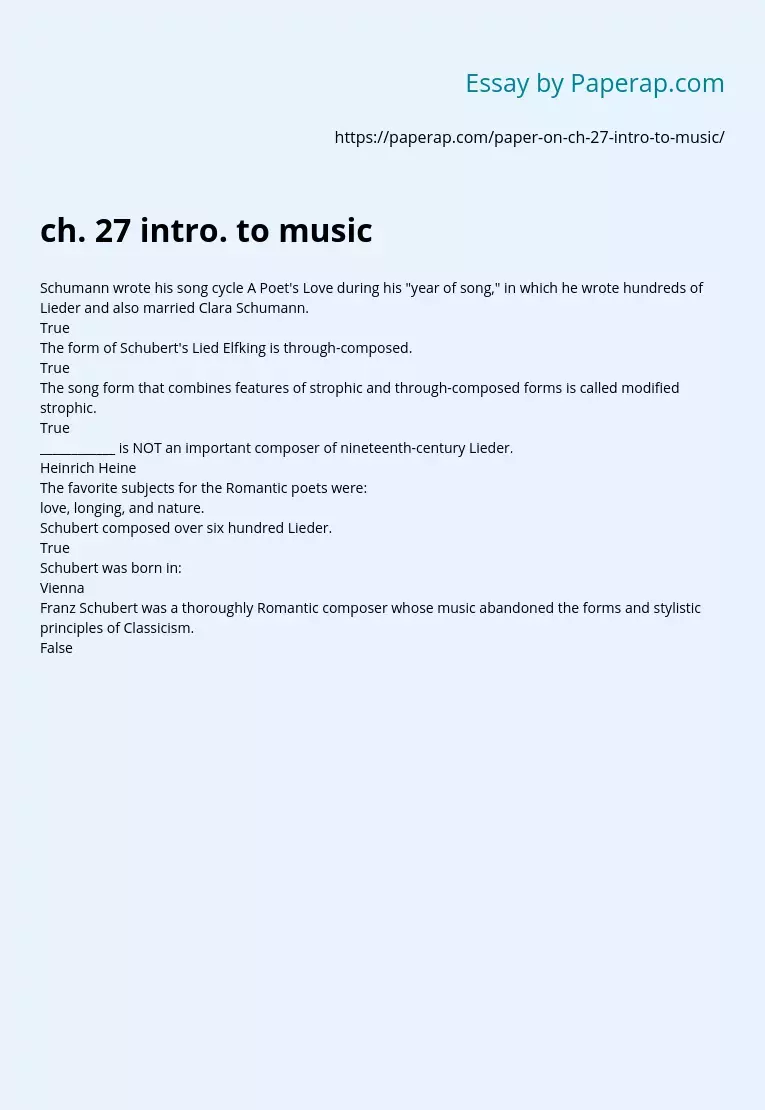ch. 27 intro. to music
Essay,
Pages 3 (641 words)
Views
43
Schumann wrote his song cycle A Poet’s Love during his “year of song,” in which he wrote hundreds of Lieder and also married Clara Schumann.
True
The form of Schubert’s Lied Elfking is through-composed.
True
The song form that combines features of strophic and through-composed forms is called modified strophic.
True
____________ is NOT an important composer of nineteenth-century Lieder.
Heinrich Heine
The favorite subjects for the Romantic poets were:
love, longing, and nature.
Schubert composed over six hundred Lieder.
True
Schubert was born in:
Vienna
Franz Schubert was a thoroughly Romantic composer whose music abandoned the forms and stylistic principles of Classicism.
False
Schubert lived a tragically short life but was a remarkably prolific composer of:
all of the above
Schumann’s A Poet’s Love is a:
song cycle.
Robert Schumann ended his career and life:
in an asylum, the result of mental illness.
The favorite Romantic poets for the composers of Lieder were:
Goethe and Heine.
In which form is the Lied Elfking?
through-composed
A song form in which the same melody is repeated with every stanza of text is called:
strophic
Goethe and Heine were two of the leading nineteenth-century writers whose poetry was set by Lieder composers.
True
Schubert organized evening gatherings of artists, writers, and musicians, called:
Schubertiads.
Which of the following does NOT describe Schumann’s “In the lovely month of May”?
It ends with harmonic resolution.
Robert Schumann’s wife, Clara, was:
all of the above
A group of Lieder unified by some narrative thread or a descriptive or expressive theme is called:
a song cycle.
Which of the following was NOT a typical theme of the Romantic Lied?
praise of the Virgin Mary
Schumann concentrated on intimate piano and vocal works and wrote no symphonies.
False
A German-texted song with piano accompaniment that sets a short lyric poem is called:
a Lied.
The rise of the piano as a household instrument influenced the popularity of the Lied.
True
A song structure that is composed from beginning to end without repetition of whole sections is called:
through-composed.
A song in which the same melody is repeated with every stanza of the text is in strophic form.
True
Schumann’s “In the lovely month of May” is from which song cycle?
A Poet’s Love
In Schubert’s Elfking, the obsessive triplet rhythm of the piano accompaniment represents:
the galloping of the horse.
Approximately how many songs did Schubert compose?
more than 600
The composer who founded the New Journal of Music was:
Robert Schumann.
Robert Schumann’s A Poet’s Love is set to texts by:
Heinrich Heine.
A song that is composed from beginning to end without repetitions of whole sections is in strophic form.
False
What is the form of “In the lovely month of May”?
strophic
Which musical devices help to portray the child’s terror in Elfking?
high range and dissonance
The mood of Schumann’s “In the lovely month of May” is joyful and exuberant.
False
Robert Schumann was married to the gifted pianist and composer Clara Wieck.
True
Which of the following does NOT describe Schumann’s A Poet’s Love?
It tells a detailed story of a lost love.
A song form where the main melody is repeated for two or three stanzas but has new or significantly varied material introduced when the text requires it is called:
modified strophic.
Schubert’s prolific output includes works of every major genre.
True
Schubert wrote several song cycles, including:
Winter’s Journey.
In which genre is Schubert NOT indebted to Classical traditions?
Lied
Schubert’s song Elfking was a setting of the ballad written by:
Goethe
The German term for the art song is:
Lied
Schumann was a carefree spirit with a happy disposition who lived a long, productive life as a composer.
False
The poem Elfking was written by Heinrich Heine.
False
Which of the following is true of Schubert’s Elfking?
all of the above
ch. 27 intro. to music. (2017, Dec 20). Retrieved from https://paperap.com/paper-on-ch-27-intro-to-music/
